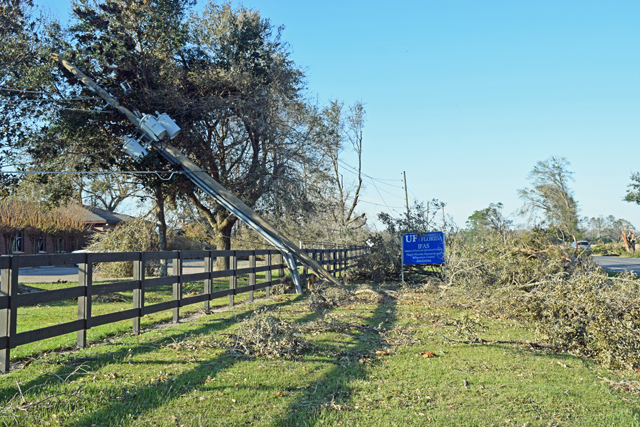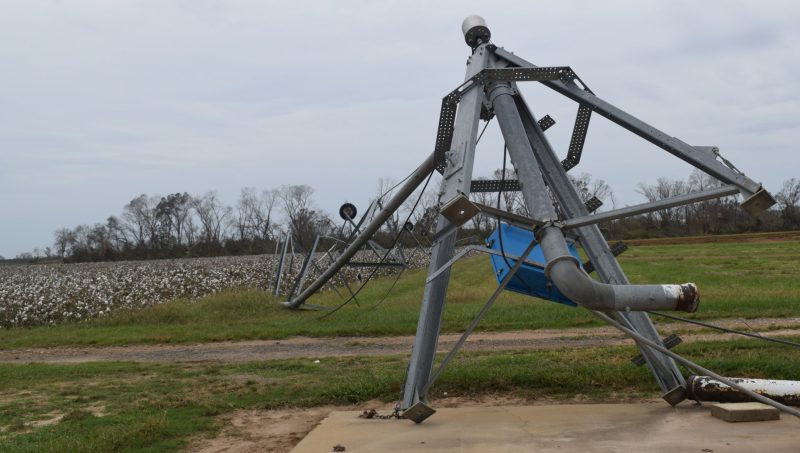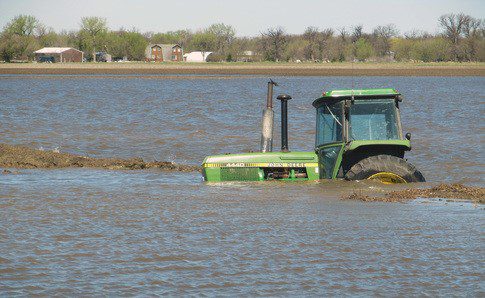––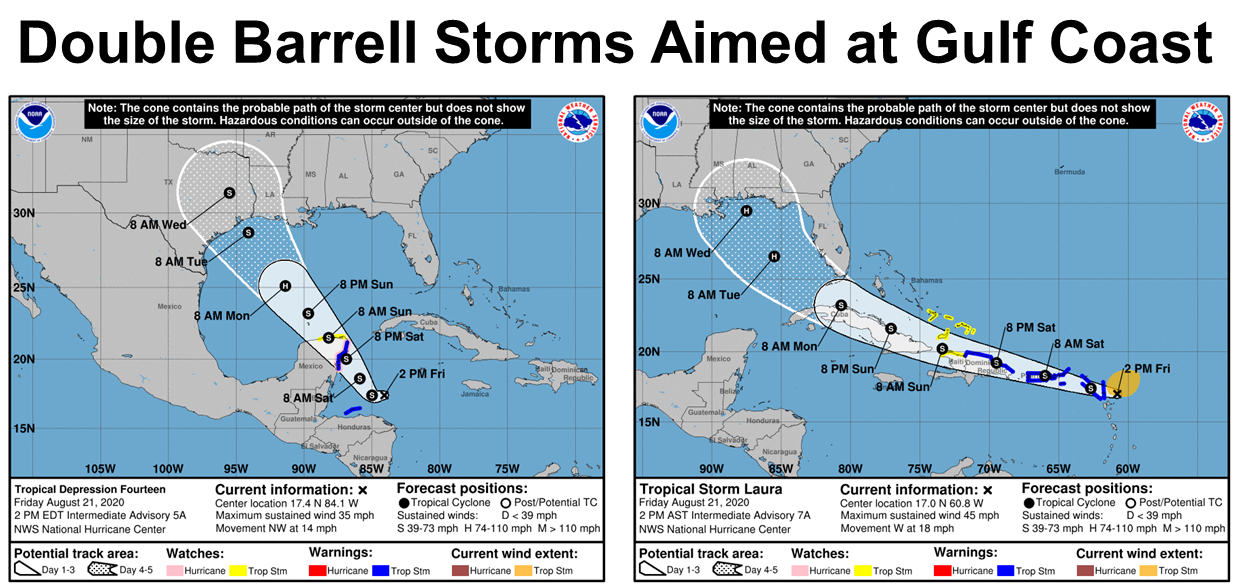
Farmers in the Panhandle are certainly familiar with watching hurricanes move through the Gulf and keeping a close eye on forecast paths. As of 2:00 PM Friday, there are two storms expected to pass through the Gulf this weekend and make landfall next week. It is still way too early to know what to expect and the exact locations of landfall, but I feel like a double-barrelled shotgun has been fired with both triggers pulled, aimed at the Gulf Coast States. It is time to review your disaster plan for your farm, because we have two cyclones of disturbance merging into the same general area.
Based on the current information from the National Hurricane Center, farmers in the Western Panhandle can expect impacts sometime on Tuesday from hurricane Laura, so you do have a few days to make preparations. A lot can change over the next few days, but preparation time is somewhat limited. If nothing else spend some time discussing the following ideas with employees and family members to develop a specific Disaster Plan for Your Farm. It is impossible to be totally prepared for a disaster, but you should at least consider how to best prioritize your time over the the next four days.
–

Mark Mauldin, Washington County Agriculture and Natural Resources Agent, speaks with a producer about his hurricane losses
Resource People
After a major storm, large areas in the path are in chaos. It is important to have a good list of current contact information for important people. While most of us rely on the phone numbers already loaded on our smart phone to do our daily business, it is a good idea to develop a printed list, just in case your cell phone becomes damaged, or you need others to help with making calls. Make sure you have current phone numbers for:
- Extended family – Everyone will want to know you are ok after the storm, and you will want to do the same.
- Employees and their families – this is a good time to review numbers of key people just to make sure you have current numbers.
- Veterinarian – not just the office number but a cell phone number as well
- Neighbors – in rural areas neighbors helping neighbors are the first responders
- Farm Service Agency Office – Damages should be reported within 15 days after the storm.
- Insurance providers – farm, cars, home, equipment, etc.
- Utility Company – Report downed power lines and power outages, so your farm can be added to their response list. Never assume they know already. The squeaky wheel concept holds true.
- County Extension Offices– Agricultural Extension Agents serve as the ESF 17 Coordinators for each county emergency team. It is their role to assist farm and livestock owners after the storm. Extension Agents are also part of the State Agriculture Response Team lead by the Florida Department of Agriculture, so they are your local contact in each county for assistance for farms and livestock owners following a disaster.
–
Loss of Power
At the very least, farmers in rural areas can expect power outages following a hurricane. In rural areas, power may not be restored for 2-4 weeks. This can cause some real problems for farmers.
- Order fuel to top off farm fuel tanks for tractors and equipment. Fuel deliveries may be disrupted following the storm.
- Fill farm and family vehicles with gas. Local gas stations may not be open for several days after the storm passes.
- Purchase batteries for flashlights and lanterns. Have enough flashlights ready for each employee.
- Stock up on feed for animals receiving supplemental feeds. Don’t forget the cat and dog food. Have enough hay, feed and health care supplies on hand for 1-2 weeks. Feed stores may not be open for business for a week or more after a storm.
- Move animals to pastures with ponds, so water troughs are not the only source of water. Have a generator ready for well operation, if ponds are not adequate.
- Dairy farms should have enough generator power so that cows can be milked each day.
- For operations that rely on electric fencing, have a generator ready to keep the fence hot, or at least move animals to interior pastures so they have multiple fences to help keep them in.
–
High Winds
Coastal areas normally receive the highest winds as a hurricane comes ashore, but even 50-70 mile per hour winds can create some real problems for livestock producers. Barns and fences are very susceptible to fallen trees and limbs from even tropical storm force winds. Tornadoes are also common in rural areas as storms move through.
- Make sure chainsaws are in good working order and stock up on mixed fuel.
- Locate chains and come-a-long for limb and tree movement off of fences and buildings.
- Stock up on fence repair materials: wire, posts, and staples for repairing fences damaged by limbs and trees. Have some T-Posts on-hand for quick emergency repairs along highways.
- Move animals and valuable equipment out of barns. Most agricultural barns are not made to withstand more than 75-100 mile per hour winds with out some damage. Metal roofing material falling and flying around can be deadly. Normally open fields or pastures are much safer for both animals and equipment. Animals out in the open have a way of avoiding danger most of the time.
- Move animals to interior pastures so there are multiple fences between animals and the highway or neighbors.
- Identify cattle and horses, so that if they do wander out of your property, you can be notified of their whereabouts. Halters or collars and luggage tags can be used for horses. If nothing else is available, spray paint your name and phone number on cattle or horses, so they can be returned to you following a storm. Do not include Coggins number on any identification, because that would allow the animal to be sold at auction.
- Pick up debris that might become high-wind hazards. Strap down feeders, trailers and other items that might blow around and injure animals or cause damage to facilities. Be prepared to remove and clean up broken limbs and uprooted trees on cowpens, fences and buildings following a storm.
–
Flooding
Tropical storms and hurricanes can generate 3-15 inches of rain in just a few hours.
- Move tractors, equipment, hay, or other stored items to highest ground.
- Move animals out of low lying pastures, or at least tie the gates open so they can move to higher ground if need be.
- Have enough hay on hand to feed for two weeks in case grass runs short from low areas being flooded.
- Make sure drainage ditches are clean without blockage.
–
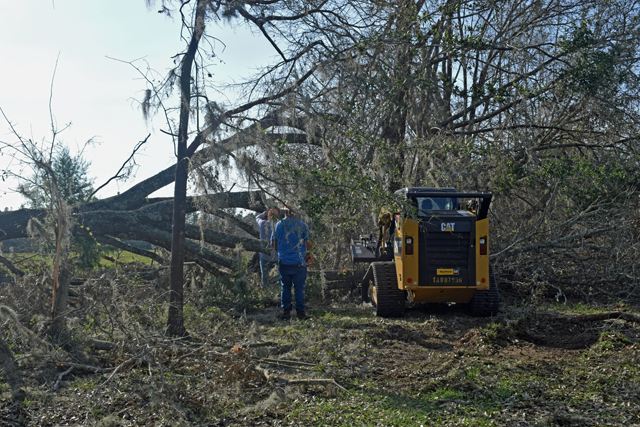
Debris removal and emergency fence repairs to keep cattle off highways after Hurricane Michael. Credit: Doug Mayo
Clean Up and Damage Assessment
Notification and documentation are the keys to getting financial aid following a major storm.
- Beware of downed power lines. Treat them as if they are charged even if they are damaged or knocked down by tree limbs. If you drive up near a downed power line, stay in your vehicle, and contact emergency personnel or the utility company.
- Contact insurance agencies as soon as possible after the storm passes for buildings, vehicles, and equipment that are insured.
- Report major damage to the local Farm Service Agency within 15 days of the storm to be eligible for federal disaster aid.
- Document damage and repair expenses. Photographs of damages and receipts for services and materials will be very important when applying for insurance claims and federal disaster aid. Any purchased feed, supplies or veterinary expenses related to storm damage should be recorded as well.
–
Other Resources available to aid with Farm Disaster Preparedness and Recovery
-
National Hurricane Center for latest storm track and forecast
-
UF Hurricane Preparedness & Recovery Farmers and Ranchers
-
FDACS Disaster Preparedness for Livestock
-
EDEN Equine Hurricane Preparedness Video
-
FDACS Disaster Preparedness for Horses
-
Emergency Considerations for Beef Cattle
-
EDEN Honey Bee Hurricane Preparedness Video
-
Assessment and Management of Hurricane Damaged Timberland
-
UF Disaster Handbook Hurricane Ag & Livestock
-
UF Family Hurricane Preparedness Plan
-
USDA Disaster Assistance Programs
-
Florida County Emergency Management Directory
-
Farm Service Agency Office Directory
–
- November 2025 Weather Summary & Winter Outlook - December 5, 2025
- Friday Feature: The History of Beekeeping - December 5, 2025
- Friday Feature:Malone Pecan Festival Tractorcade - November 21, 2025

